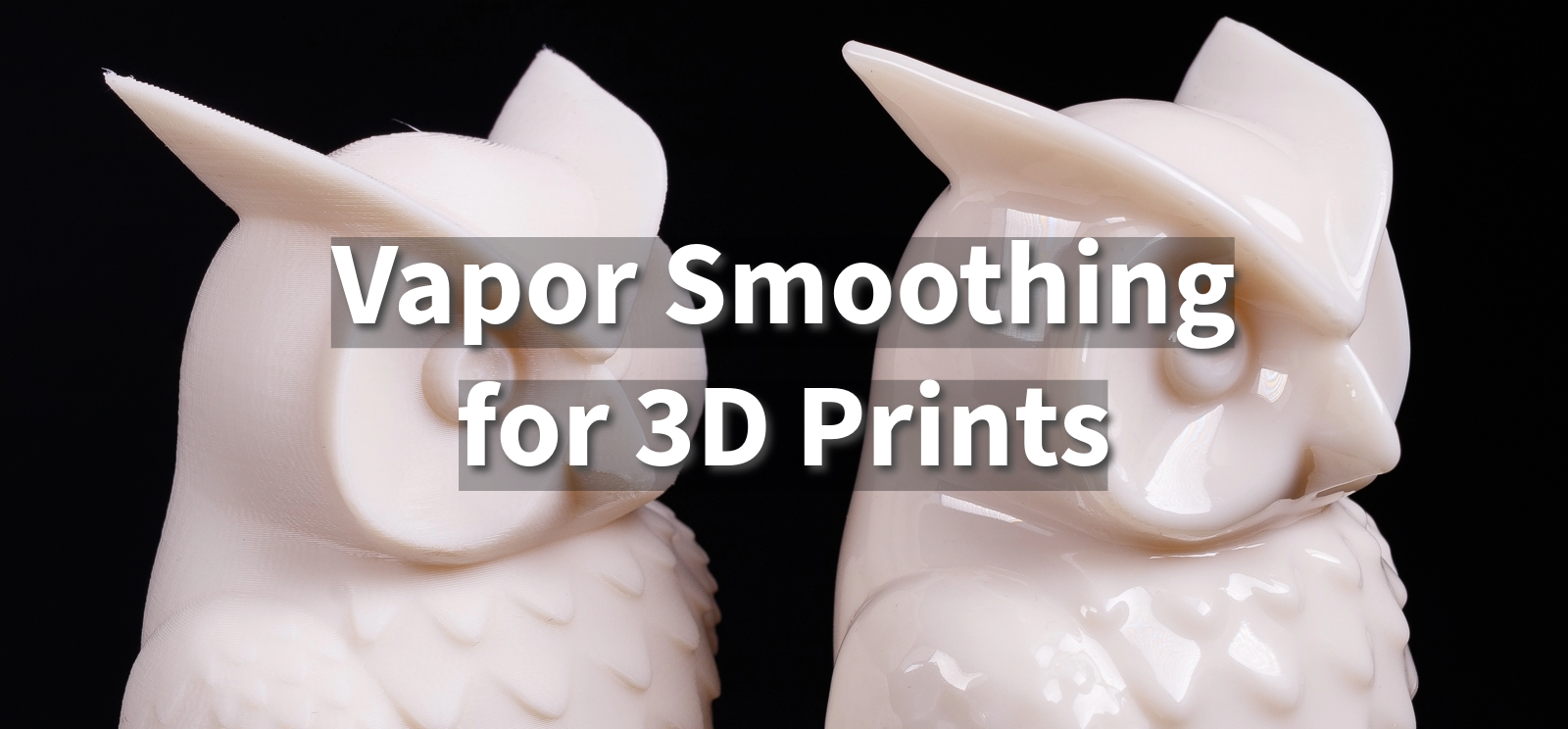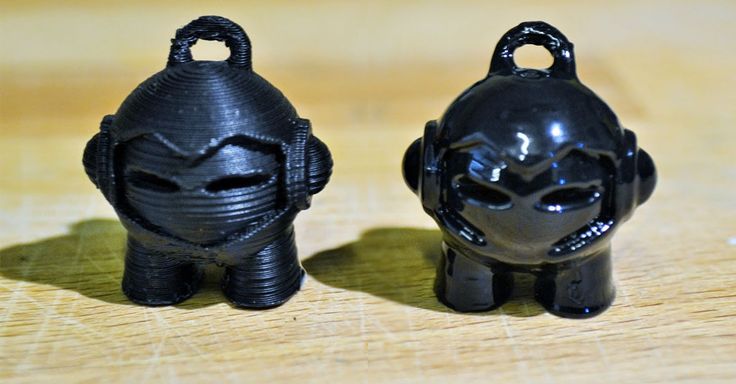Vapor Smoothing for 3D Prints: A Complete Guide

Discover how vapor smoothing enhances the finish of 3D printed parts, achieving smooth, professional results by reducing visible layer lines
Introduction to Vapor Smoothing
Vapor smoothing is a surface finishing process used to make 3D printed parts look smooth and shiny. It works by using chemical vapors to slightly melt the outer layer of the 3D print, which helps remove the rough lines left by the printing process. This technique is popular because it improves the appearance of parts without requiring a lot of manual effort.
One commonly used method is acetone vapor smoothing, which is especially effective for smoothing 3D prints made from ABS (Acrylonitrile Butadiene Styrene). Acetone is a solvent that softens the surface of ABS, allowing it to melt just enough to become glossy and smooth. The result is a professional-looking finish that makes the 3D printed part appear polished and more durable.
How Vapor Smoothing Works
Vapor smoothing works by exposing a 3D printed part to chemical vapors that react with the surface material. The part is placed in a sealed chamber along with the solvent, which is gently heated to create vapors. These vapors then condense on the surface of the part, causing it to soften and melt slightly. This process smooths out the layer lines and gives the part a shiny, uniform appearance.
Typical Solvents Used
The effectiveness of vapor smoothing depends on the compatibility between the solvent and the material of the 3D print. For example, acetone is commonly used for ABS because it effectively softens the surface without damaging the overall structure. For other materials like PLA (Polylactic Acid), different solvents such as tetrahydrofuran (THF) or ethyl acetate may be used. The choice of solvent is crucial, as it must be able to soften the material enough to smooth it, but not so much that it causes deformation.
Benefits of Vapor Smoothing in 3D Printing
Enhanced Surface Finish and Aesthetics: Vapor smoothing significantly improves the appearance of 3D printed parts by removing visible layer lines, resulting in a smooth, glossy finish that looks professional.
Improved Part Strength and Layer Adhesion: By melting the outer layer, vapor smoothing helps fuse the layers together, which can improve the overall strength and durability of the part.
Reduced Post-Processing Time: Compared to manual sanding or polishing, vapor smoothing is much faster and requires less effort, making it an efficient option for finishing 3D printed parts.
Vapor Smoothing ABS vs. Vapor Smoothing PLA

Source: pinterest.com
Vapor Smoothing ABS: Acetone vapor smoothing is a well-established process for ABS. Acetone is highly effective in softening ABS, which allows the surface to melt slightly and form a smooth, glossy finish. To achieve the best results, the part should be placed in a sealed chamber with acetone vapors for a controlled amount of time, usually a few minutes. Best practices include ensuring even exposure to vapors and monitoring the process to avoid over-smoothing, which could lead to deformation.
Vapor Smoothing PLA: Vapor smoothing PLA is more challenging because acetone is not effective for this material. PLA does not dissolve well in acetone, which means alternative solvents, such as tetrahydrofuran (THF) or ethyl acetate, must be used. These solvents can smooth PLA, but the process is less predictable compared to ABS. Additionally, PLA is more prone to warping and deformation during vapor smoothing, so it requires careful handling and precise control of vapor exposure to avoid damaging the part.
Methods of Vapor Smoothing
DIY Methods: For those interested in trying vapor smoothing at home, a basic chamber setup can be made using a glass container with a secure lid. The 3D printed part is placed inside the container along with a small amount of solvent, such as acetone for ABS. The container is then gently heated to create vapors. Safety is crucial when using DIY methods—ensure the area is well-ventilated, avoid open flames, and always wear protective gloves and goggles. The instructions should be followed carefully to avoid accidents or damage to the part.
Professional-Grade Vapor Smoothing Equipment: Professional vapor smoothing machines are designed to provide consistent results with improved safety and efficiency. These machines automatically control the temperature and vapor exposure, ensuring an even finish without the risk of over-smoothing or warping. Using professional-grade equipment offers several advantages, including better precision, reduced risk of damage, and the ability to handle larger batches of parts, making it ideal for commercial applications.
Applications of Vapor-Smoothened 3D Prints

Source: global3d.com
Industries that Benefit from Smooth 3D Prints
Several industries benefit from the improved aesthetics and functionality of vapor-smoothed 3D prints. The automotive industry uses smooth parts for prototyping and even end-use components that require a polished look. The medical industry benefits from vapor-smoothed prints for producing models and medical devices that need to be both precise and easy to sterilize. Consumer products such as custom toys, household items, and gadgets also benefit from the enhanced appearance and durability that vapor smoothing provides.
Use Cases Where Vapor Smoothing Makes a Difference
Vapor smoothing is particularly beneficial for products that need a professional, high-quality appearance. For instance, functional prototypes used in presentations or product testing benefit from the smooth finish, which makes them more representative of final production models. End-use parts that are meant to be handled frequently, such as tool handles or decorative items, also benefit from the enhanced durability and comfort provided by vapor smoothing. Additionally, wearable items, like custom jewelry or fashion accessories, gain an appealing, polished appearance that enhances their value.
Safety Tips and Best Practices
Essential Safety Precautions
When handling solvents for vapor smoothing, always prioritize safety. Work in a well-ventilated area to avoid inhaling harmful fumes, and wear appropriate personal protective equipment, such as gloves, goggles, and a mask. Keep solvents away from open flames or heat sources, as many are highly flammable. Always store solvents in properly labeled, sealed containers, and follow all safety instructions provided by the manufacturer.
Tips for Consistent, High-Quality Finishes
To achieve consistent, high-quality finishes, ensure that the vapor smoothing chamber is properly sealed to prevent solvent loss. Monitor the temperature carefully to avoid overheating, which could cause warping or deformation. Rotate the part if necessary to ensure even exposure to vapors.
Timing is crucial—do not leave the part in the vapor for too long, as over-smoothing can lead to loss of detail or structural integrity. Practice and experimentation will help determine the ideal conditions for each type of material.
Conclusion
Vapor smoothing is an effective post-processing technique for improving the surface quality of 3D printed parts. It offers numerous benefits, including enhanced aesthetics, improved part strength, and reduced post-processing time. By choosing the right solvent and method, whether DIY or professional-grade, you can achieve consistent, high-quality results for a variety of materials.
When deciding on the best post-processing method for your 3D prints, consider the specific material, desired finish, and application requirements. Vapor smoothing is an excellent choice for ABS and other compatible materials, providing a polished, professional appearance that makes 3D printed parts suitable for a wide range of industries and uses.
AutofabX: Elevate Your 3D Prints to Perfection
Achieve flawless finishes with expert vapor smoothing solutions!
Discover how AutofabX can help you achieve seamless finishes and enhanced durability. Contact us today to bring professional polish and precision to your designs.
